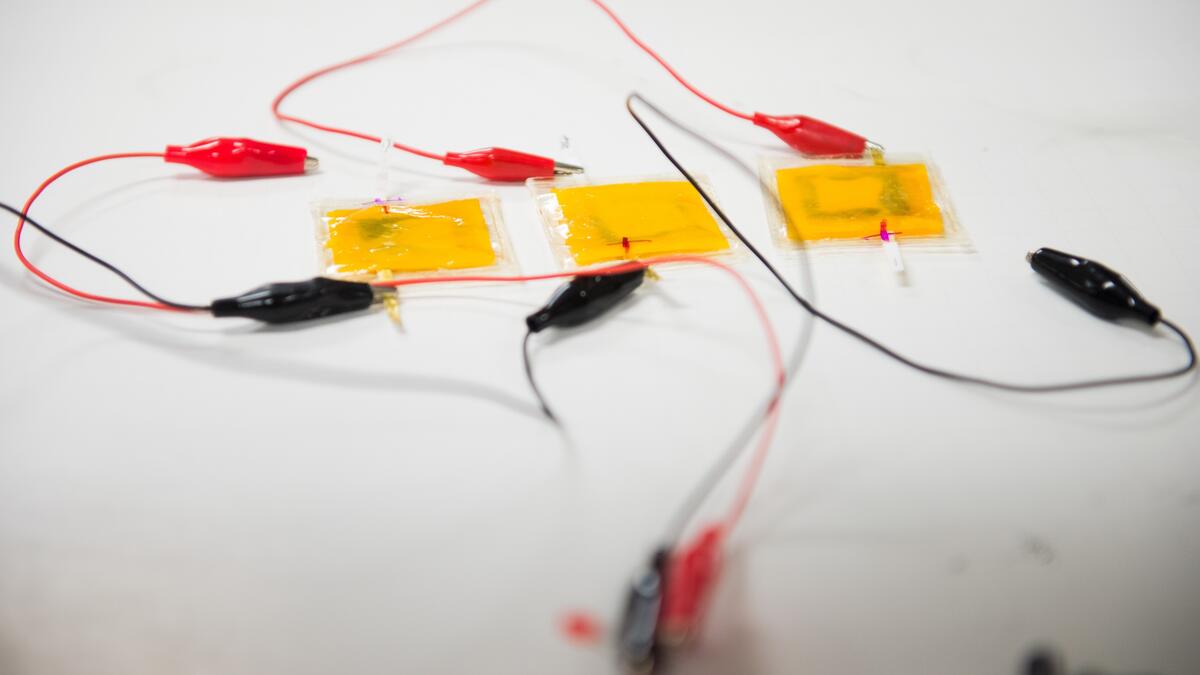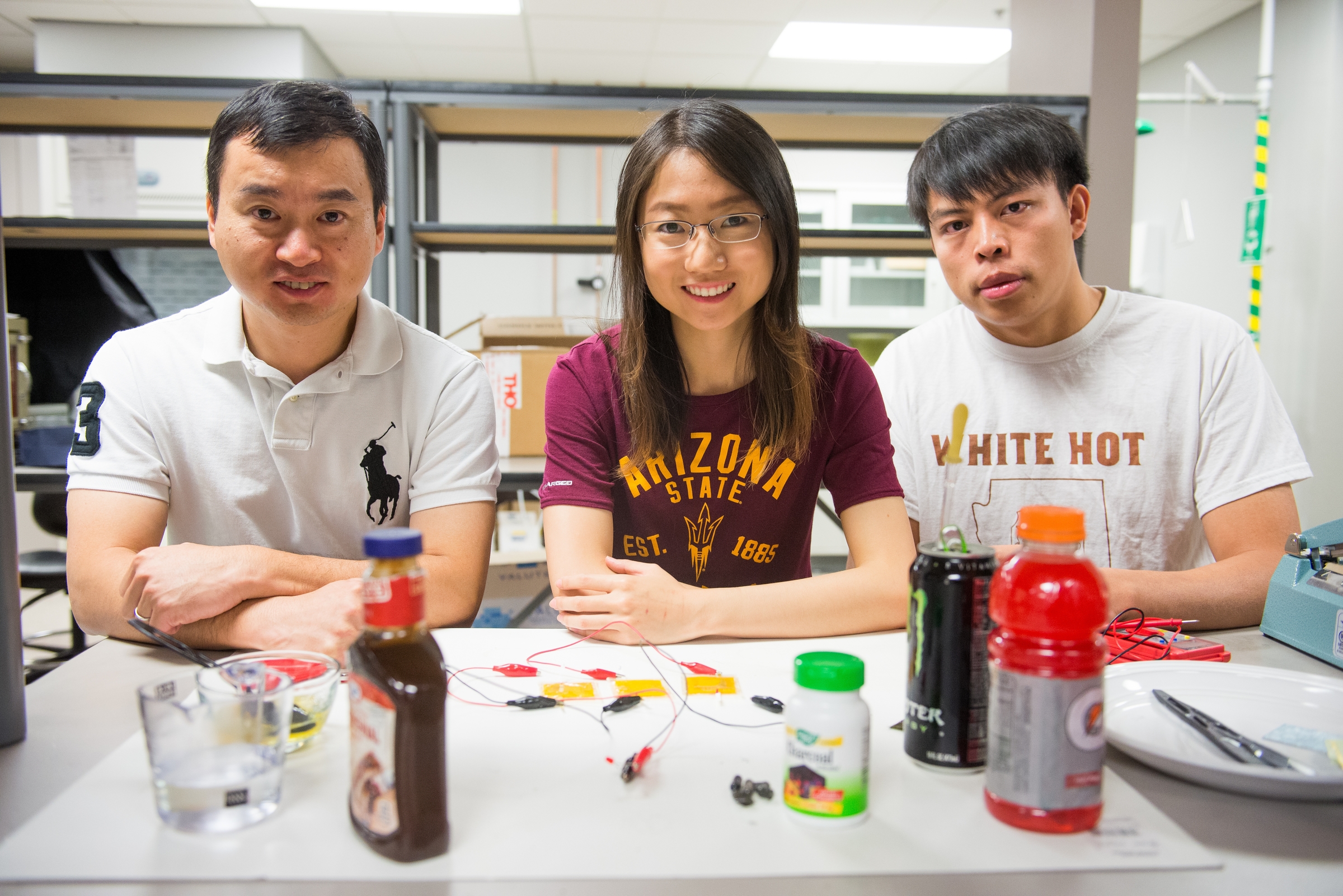Health food just took on a whole new meaning.
Engineers have created an edible supercapacitor that can wipe out E. coli or power a camera from inside the body.
Foods like activated charcoal, gold leaf, Gatorade, seaweed, egg white, cheese, gelatin and barbecue sauce can store and conduct electricity. Sandwich them together, and you have a supercapacitor — a high-capacity electrical component that can store electrical energy temporarily.
“We know it’s possible to make devices from food,” said Hanqing Jiang, an associate professor of mechanical engineering in the School for Engineering of Matter, Transport and Energy in Arizona State University’s Ira A. Fulton Schools of Engineering.
Researchers proved in the lab that the devices (seen above) can kill E. coli. “We’re trying to kill other bacteria as well,” Jiang said.
They also proved the devices can power a camera while in the stomach.
“The main application is to pass through a (gastrointestinal) tract, doing whatever a GI doctor needs,” Jiang said.
The supercapacitor could replace endoscopies with real-time monitoring of the gastrointestinal tract.
You wouldn’t want to pass them around at a party. Asked what the combination tastes like, Jiang replied, “It is cheese.”
The paper (not the recipe) was published Monday in Advanced Materials Technologies (not Bon Appetit). Recipes usually don’t read like this:
“The slurry was coated on the current collector by doctor’s blading followed by overnight drying in ambient environment and 6 hours drying in room temperature, low pressure (10 Pa) chamber to avoid thermal stress as well as remove the water in the electrode.”
Ingestible electronics do exist, but they need to be passed from the body. There are other concerns as well, Jiang said.
“The concern is that it’s not digestible,” he said of the previous ingestible electronics. “If it breaks, there is a possibility of contamination.”
The invention cracks a number of problems. Implantable electronics require surgery. Biodegradable electronics exist, but they have low energy density and battery size is limited. Edible materials proposed in the past have toxic components that can cause stomach pain and nausea.
Jiang and his team went interdisciplinary, weaving together the food industry, material sciences, device fabrication and biomedical engineering.
Carbon is already used in supercapacitors. Jiang chose activated charcoal and gold leaf because they both have high electrical conductivity and chemical stability. Gold is used extensively in Indian cuisine, and the European Union classifies gold as a drug. It acted as a current collector in the research.
Hanqing Jiang (left) and his students, chemical engineering student Wenwen Xu and mechanical engineering student Xu Wang, with the ingredients for the supercapacitor "recipe" in Jiang’s lab on May 10 on the Tempe campus. Photos and video by Ben Moffat/ASU Now
The devices were made by hand. In future they’ll be made by 3-D printers and will be much smaller than the “sandwiches” made by Jiang and his students, which are a little bit bigger than a soy sauce packet.
Jiang and three students have been working on the project since August. Currently he is discussing the next steps in application with Mayo Clinic officials.
Meanwhile, business operations managers thought Jiang was catering a party on the university dime when he filed his expense report.
“The funny thing is when we got all the materials in, I had a hard time getting reimbursed,” he said. “It was all food.”
Professor Shelley E. Haydel, Center for Infectious Diseases and Vaccinology, the Biodesign Institute, and professor Lenore Dai, director of the School for Engineering of Matter, Transport and Energy, collaborated with Jiang on the research. Other co-authors were 2016 ASU grads Prithwish Chatterjee, currently working at Intel Corporation; 2016 ASU graduate Zeming Song; mechanical engineering PhD student Cheng Lv; and PhD student in Biodesign John Popovich.
More Science and technology

ASU at the heart of the state's revitalized microelectronics industry
A stronger local economy, more reliable technology, and a future where our computers and devices do the impossible: that’s the transformation ASU is driving through its microelectronics research…

Breakthrough copper alloy achieves unprecedented high-temperature performance
A team of researchers from Arizona State University, the U.S. Army Research Laboratory, Lehigh University and Louisiana State University has developed a groundbreaking high-temperature copper alloy…

4 ASU researchers named senior members of the National Academy of Inventors
The National Academy of Inventors recently named four Arizona State University researchers as senior members to the prestigious organization.Professor Qiang Chen and associate professors Matthew…



